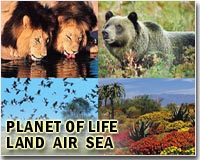| . |  |
. |
Durham, England (UPI) Aug 18, 2010 The disappearance of ancient grasslands, not human hunting, may have led to the extinction of animals such as the woolly mammoth, U.K. researchers say. Scientists at Durham University in England say the new findings challenge accepted theories that humans played a large part in the extinction of woolly mammoths, woolly rhinos and cave lions through hunting, competition for land and pressure on habitats, Science Daily.com reported Tuesday. Instead, a massive reduction in grasslands and the spread of forests may have been the primary cause of the decline, they say. The researchers studied data on climate and vegetation in the Northern Hemisphere during and after the height of the last Ice Age, 21,000 years ago. Over a huge part of the Earth's surface, they say, there was a massive decline in the productivity and extent of grasslands due to climatic warming and the spread of forests. "Woolly mammoths retreated to northern Siberia 14,000 years ago whereas they had roamed and munched their way across many parts of Europe, including the U.K., for most of the previous 100,000 years or more," Professor Brain Huntley said. "The change from productive grasslands across large areas of northern Eurasia, Alaska and Yukon to less productive tundra-like habitats had a huge effect on many species. "We believe that the loss of food supplies from productive grasslands was the major contributing factor to the extinction of these mega-mammals." He called the findings "a model for what may happen as a result of rapid climate change over the next century linked to human activity." "It is food for thought in these times of global warming and human-induced habitat change," he said. "There may well be a lesson to learn."
Share This Article With Planet Earth
Related Links Darwin Today At TerraDaily.com
 Project will sequence all human bacteria
Project will sequence all human bacteriaSt. Louis, Miss. (UPI) Aug 17, 2010 U.S. scientists say they will undertake a project to sequence the genetic content of all the bacteria that live in the human body - about 900 types. Though it might have a lower profile than the Human Genome Project that preceded it, the Human Microbiome Project, funded by the U.S. government, could have equally important implications, Britain's Daily Telegraph reported Tuesday. ... read more |
|
| The content herein, unless otherwise known to be public domain, are Copyright 1995-2010 - SpaceDaily. AFP and UPI Wire Stories are copyright Agence France-Presse and United Press International. ESA Portal Reports are copyright European Space Agency. All NASA sourced material is public domain. Additional copyrights may apply in whole or part to other bona fide parties. Advertising does not imply endorsement,agreement or approval of any opinions, statements or information provided by SpaceDaily on any Web page published or hosted by SpaceDaily. Privacy Statement |